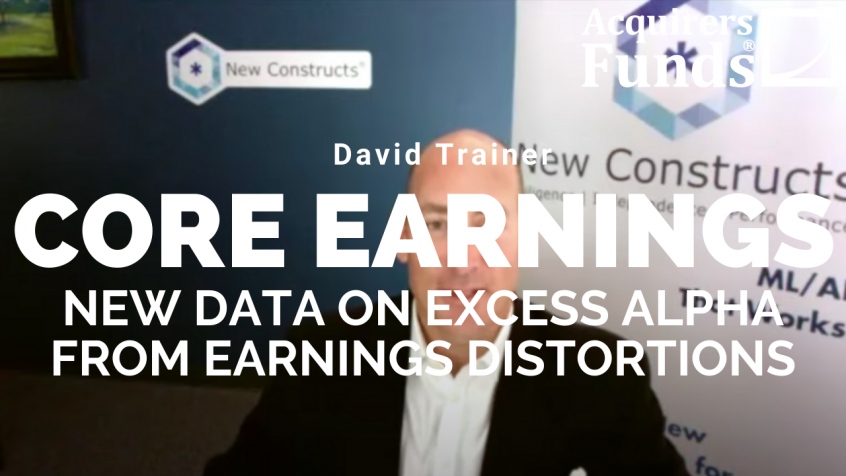During their recent interview on The Acquirers Podcast with Tobias, David Trainer, CEO of New Constructs discussed Using AI To Decipher Footnotes. Here’s an excerpt from the interview:
David: Yeah, let’s get nerdy here, because the reason we came to get in touch with the folks at Harvard Business School is because the professor, Charles Wang, he said, “David, I have a problem.” This is going back a few years ago. It’s not a problem any more. But the problem was, “Students don’t want to take my class. They don’t see any reason to go through these filings and dig through the footnotes to find these items. So, there’s no reason to teach financial statement analysis because they don’t think it matters. Or, it’s not enough of an edge to justify the time it takes to do that work.” I said, “Well, what if there was technology that made getting that extra information costless or very inexpensive, so you could operate with the advantage of doing that work across thousands of companies without having to take the time to do it?” Charles said, “That’s really interesting. I’d love to know more about that.” That’s what led to a case study and a paper, and papers.
The key is, how does this what we call Robo-Analyst technology work? How does it make going through filings better, faster, and cheaper? The first part of the answer, Toby, is that, it’s not that exciting. We started building this machine learning natural language processing capability back in 2002. We were drawing with the plans, we completed in 2003, and it’s really just a fancy mechanism for copying what an expert would do and going through a file. So, there’s been no fancy algorithm that we created that can automatically figure out how to deal with the data. We have found that there’s no substitute for experts engaging with the data, the source. We just do that with technology that allows us to teach machines to do what experts do.
The first thing that happens is that the filing comes in and it’s not press releases actually, Toby, because they don’t contain adequate disclosures. You don’t get the details you need until you get to the Qs, and oftentimes, until you get to the Ks. For example, sometimes, a Q has partial disclosures, and you don’t know the real answer to the annual report. But to answer your question, specifically, yes, the filing comes in and it goes through a process that the machines go through in and autoparse, and identify, and tag all kinds of stuff that gets reviewed by a human. Then that gets run through a model. That result gets again reviewed by a human. All the while it’s parsing and running data checks that compare what’s been done in the past, so that we can always take advantage of the intelligence that we’ve accumulated in our system based on what the experts have done over the last 18 years.
Tobias: It always interested me to know because by the very nature that each note is going to be a little bit idiosyncratic, it is some exception to what is auditable in the filings themselves or in the financial statements themselves. So, how do you get these things that are idiosyncratic, and each one of them is potentially unique, and then work that back into the financial statement?
David: That’s a great question and it was one that I came to over a lot of time when I was doing this work manually back in my Wall Street days pre-tech bubble. I went through a lot of files. In the beginning, I didn’t think it would be possible it’d ever occur to me. But as I cut into the super nerd range of looking at thousands of filings, I did see that there was pretty consistently a pattern. There’s a lot of differences, there’s a lot of idiosyncratic reporting, but there’s enough consistency there that you can get a machine to do a lot of the work, and that’s how our system works. We only let the machine do the work that it’s 100% sure of, and when we see something that doesn’t fit the pattern, it’s knocked up to the analysts to review it as an exception. So, we’ve been able to churn through many, many, many, many exceptions. We see that there’s actually a pattern with in exceptions.
Look, you can get 50% of it automatic the first time through and then you can get the next 50%, you knock out 25% of that, and 25% of that. So, we’re constantly chopping down over time how much we require a human expert to go through the filing. Every time, the expert says, “Oh no. Here’s how you deal with that,” that gets added to the machine’s memory bank of how to handle a certain situation so that if that exception ever comes again, then the machine can handle it.
You can find out more about Tobias’ podcast here – The Acquirers Podcast. You can also listen to the podcast on your favorite podcast platforms here:
For all the latest news and podcasts, join our free newsletter here.
Don’t forget to check out our FREE Large Cap 1000 – Stock Screener, here at The Acquirer’s Multiple:



